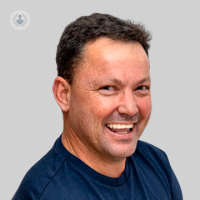What is acromial decompression?
Written by:Read on below to find out all about acromial decompression surgery, including the benefits, risks, and recovery time afterwards, as esteemed physiotherapist, Ian Repton, gives us an insightful guide.

What is acromial decompression?
Acromial decompression, also known as subacromial decompression, is a surgical procedure commonly performed to treat shoulder impingement syndrome, a condition characterised by the compression or pinching of the tendons and soft tissues in the shoulder joint. This compression typically occurs beneath the acromion, a bony prominence at the top of the shoulder blade (scapula), resulting in pain, inflammation, and restricted range of motion in the shoulder.
What is the main aim of this surgery?
The goal of acromial decompression is to alleviate symptoms by creating more space within the subacromial space, and as a result, reducing pressure on the tendons and soft tissues in the shoulder joint. This is achieved by removing a small portion of the acromion and any associated bone spurs or irregularities that may be contributing to impingement.
How is acromial decompression performed?
The procedure is typically performed arthroscopically, using small incisions and specialised instruments inserted into the shoulder joint through narrow tubes called cannulas. This minimally invasive approach allows for greater precision and accuracy during the surgery, as well as faster recovery times and reduced risk of complications compared to traditional open surgery.
During the procedure, the surgeon first inserts a small camera, called an arthroscope, into the shoulder joint to visualise the structures inside. This allows the surgeon to identify any abnormalities, such as bone spurs or inflammation, that may be causing impingement. Next, specialised instruments are used to carefully remove a portion of the acromion and any other bony prominences that may be contributing to impingement.
What does recovery time entail?
Following acromial decompression, patients typically experience relief from symptoms such as pain, swelling, and restricted range of motion in the shoulder. Physical therapy and rehabilitation exercises are often prescribed to help restore strength, flexibility, and function to the shoulder joint and surrounding muscles.
The physiotherapy component of recovery following acromial decompression surgery plays a crucial role in optimising the patient's outcomes and facilitating a successful recovery. Initially, physiotherapy focuses on pain management and reducing inflammation in the shoulder joint through gentle range of motion exercises and modalities such as ice therapy.
As the patient progresses, the physiotherapist will introduce exercises to improve strength, flexibility, and stability in the shoulder, focusing on the muscles surrounding the shoulder joint, including the rotator cuff muscles. Gradually, the physiotherapy programme will advance to include more challenging exercises aimed at restoring full range of motion and functional abilities in the shoulder.
The physiotherapist works closely with the patient to ensure that exercises are performed correctly and safely, monitoring progress and adjusting the treatment plan as needed to achieve optimal outcomes. By addressing muscle imbalances, improving joint mobility, and enhancing overall shoulder function, physiotherapy plays a vital role in facilitating a smooth and successful recovery following acromial decompression surgery.
What are the associated risks?
While acromial decompression is generally safe and effective for treating shoulder impingement syndrome, as with any surgical procedure, there are potential risks and complications to be aware of, including infection, bleeding, nerve injury, and failure to relieve symptoms. It is important for patients to discuss the potential risks and benefits of acromial decompression with their surgeon and to carefully follow post-operative instructions to optimize outcomes and minimise the risk of complications.
To schedule an appointment with Ian Repton today, just visit his Top Doctors profile.


